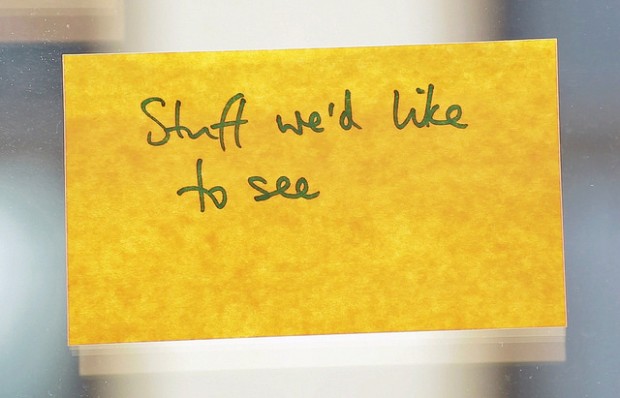
The mental health network at GDS exists to ensure our colleagues have the mental health support and information they need.
We do this in a variety of different ways. For example, we send out a regular newsletter, we have a dedicated Slack channel for discussing mental health-related topics, we provide mental health first aid, and host speakers and events.
We also hold regular anonymous peer-led mental wellbeing Q&As. In this post, I will explain how we organise them and share some tips on how to ensure they’re a success.
What we do to set up our Q&As
The Q&As take place on the morning of the last Friday of each month. We hold them on the online platform Slack, which everyone at GDS can access.
First, we field questions using a Google form, which staff can complete anonymously.
Staff can also use the form to submit answers anonymously. Our most recent Q&A had 10 anonymous questions and around 50 replies from around 20 members of staff.
It takes one person about 3 hours in total to organise and curate the 2-hour event.
People tell us the Q&As are really valuable, even if they don’t ask or answer a question.
After the Q&As, an anonymised transcript is added to a single Google document, which contains similar transcripts from all the previous Q&As.
Tips for ensuring the Q&As run well
These are the steps we take to ensure our Q&As run well:
Find a curator
This must be someone who has the time and emotional capacity to give their full attention to the Q&A when it is up and running. They will also need to be willing to field and deal with potentially tricky questions and discussions.
Set aside a regular time
A regular slot makes the Q&As easier to promote and more reliable for people. GDS Q&As are currently 2 hours long and they take place on the last Friday morning of each month.
We chose Friday mornings because we thought people would be more likely to be free from meetings, or have more privacy working from home. However, we’re thinking of trying Thursdays instead, to fall within more people’s working hours.
Let people know what support is available
At all stages we remind people where they can get urgent help. We have a page on the GDS intranet with resources and support options, including calling 999 or 111, contacting mental health charities, seeking therapy, calling the Cabinet Office listening service or contacting a GDS mental health first aider.
Be ready for urgent questions
In the event of a worrying anonymous message coming in, we have a pre-prepared message which we send out via email groups and various Slack channels, to try and reach that person and signpost them to support options.
Invite people to nominate a topic
Each Q&A centres around a particular topic, although questions on other areas are fine, of course. We use another anonymous Google form for this, with the answers going to their own tab in the spreadsheet.
Allow a couple of days for this, to help everyone get a chance to suggest topics.
Invite people to vote for a topic
Allow at least a day for this, to give people time. We ask for people's top 3, then give 3 points for a first preference, 2 points for a second preference, and 1 point for a third preference.
The voting is anonymous, and the topic with the highest score wins.
Announce the topic and timings
Let people know when the Q&A will be taking place and what the topic will be. Also, remind them of the form they can use to submit anonymous questions.
Invite people to submit questions
They can do this anonymously, in advance or during the session, via a Google form or directly on the Slack channel.
Use Google Sheets to organise the Q&A
We channel the responses from the various Google forms to different tabs on a single Google spreadsheet, which keeps everything in one place.
Guidance similar to that listed here is also included in one of the tabs in the spreadsheet, as guidance for curators.
Keep an eye on incoming questions
Copy and paste them into the Slack channel, and ask people to reply as a 'thread', not in the channel itself. Have a couple of questions prepared just to stimulate things if it dries up.
We've found that even if people aren't asking or answering questions, they are listening and are keen to hear from their peers. We usually find that one question every 10 to 20 minutes is a good pace, giving people time to respond.
Close the Q&A
When you close the discussion, remind people what support is available.
Share an anonymised transcript of the Q&A
We keep a single document of transcripts from all of the Q&As, with all names and identifiers removed, and share this internally for reference.
Other mental health initiatives at GDS
As well as the regular Q&As and peer support network, GDS has a number of trained mental health first aiders in house (in addition to those across the wider Cabinet Office) whom colleagues can approach for confidential advice and signposting. We’re recruiting and training more mental health first aiders, and working with them to ensure they have the support and resources they need.
We also have mental health and wellbeing champions and working groups who meet regularly. We have mental health support information on GDS’s intranet, which includes a list of mental health-related books in our office library.
And GDS has also made a 'Time To Change' pledge – a commitment to how we think and act about mental health in the workplace. The pledge will be published soon – watch this space!
Follow Ben on Twitter
Subscribe to this blog to get an email notification every time we publish a new post.

